

How We Could Detect an Alien Apocalypse From Earth. Artificial Intelligence Safety Engineering: Why Machine Ethics Is a Wrong Approach [pdf] : ExistentialRisk. Cecs.louisville.edu/ry/AIsafety.pdf. How Much Longer Before Our First AI Catastrophe? As I distinctly recall, some speculated that the Stock Market crash of 1987, was due to high frequency trading by computers, and mindful of this possibility, I think regulators passed laws to prevent computers from trading in that specific pattern again.
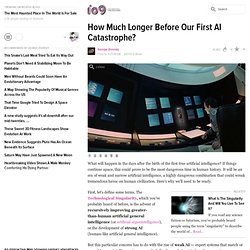
I remember something vague about about "throttles" being installed in the trading software that kick in whenever they see a sudden, global spike in the area in which they are trading. These throttles where supposed to slow down trading to a point where human operators could see what was happening and judge whether there was an unintentional feedback loop happening. This was 1987. I don't know if regulators have mandated other changes to computer trading software in the various panics and spikes since then.
But yes, I definitely agree this is very good example where narrow AI got us into trouble. These are all examples of narrow machine intelligence. Obviously no system is going to be perfect. So it goes. Ross Andersen – Humanity's deep future. Sometimes, when you dig into the Earth, past its surface and into the crustal layers, omens appear.
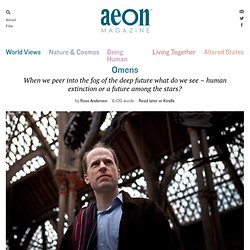
In 1676, Oxford professor Robert Plot was putting the final touches on his masterwork, The Natural History of Oxfordshire, when he received a strange gift from a friend. The gift was a fossil, a chipped-off section of bone dug from a local quarry of limestone. Plot recognised it as a femur at once, but he was puzzled by its extraordinary size. The fossil was only a fragment, the knobby end of the original thigh bone, but it weighed more than 20 lbs (nine kilos). It was so massive that Plot thought it belonged to a giant human, a victim of the Biblical flood. Last December I came face to face with a Megalosaurus at the Oxford University Museum of Natural History.
Bostrom attracts an unusual amount of press attention for a professional philosopher, in part because he writes a great deal about human extinction. Saturday Morning Breakfast Cereal. <map name="admap71632" id="admap71632"><area href=" shape="rect" coords="0,0,728,90" title="" alt="" target="_blank" /></map><table cellpadding="0" cellspacing="0" style="width:728px;border-style:none;background-color:#ffffff;"><tr><td><img src=" style="width:728px;height:90px;border-style:none;" usemap="#admap71632" alt="" /></td></tr><tr><td style="background-color:#ffffff;" colspan="1"><center><a style="font-size:10px;color:#0000ff;text-decoration:none;line-height:1.2;font-weight:bold;font-family:Tahoma, verdana,arial,helvetica,sans-serif;text-transform: none;letter-spacing:normal;text-shadow:none;white-space:normal;word-spacing:normal;" href=" target="_blank">Ads by Project Wonderful!
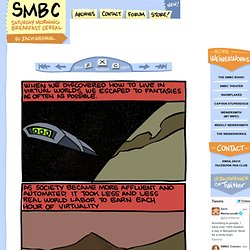
Your ad here, right now: $0</a></center></td></tr></table> Archives Contact Forum Store! November 22, 2013 Thanks to the lovely geeklings at Columbia, Yale, and Harvard, for a lovely nerdtastic voyage. Discuss this comic in the forum November 21, 2013 Hey geeks! November 20, 2013 Whee! The Corliss Resolution. The Astronomer Royal tells io9 how he plans to save humanity from extinction. I'm in favor of this kind of long-range thinking, but worry that concentrating on extremely long-range scenarios like grey goo will discredit the entire enterprise.

Eric Drexler's vision of nanotech - tiny molecules interacting mechanically - has gone nowhere in the 20 years since "Engines of Creation", and has been roundly dismissed by actual chemists and molecular biologists. What people call nanotechnology today is just a complex form of chemistry, not a means of building artificial life. As it is, we don't know how to build Drexlerian structures, and even if we did don't know how to make them replicate, and even if we did don't know how to make them compute efficiently, and and even if we did don't know how to make them intelligent. What are the chances that a particle collider's strangelets will destroy the Earth? (Phys.org) —At the Relativistic Heavy Ion Collider (RHIC) at Brookhaven National Laboratory (BNL) in Long Island, New York, scientists study high-speed ion collisions that reveal what the universe may have looked like moments after the Big Bang.
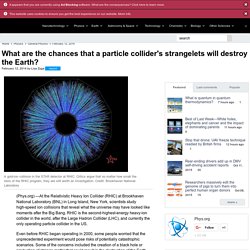
RHIC is the second-highest-energy heavy-ion collider in the world, after the Large Hadron Collider (LHC), and currently the only operating particle collider in the US. Even before RHIC began operating in 2000, some people worried that the unprecedented experiment would pose risks of potentially catastrophic scenarios. Some of the concerns included the creation of a black hole or production of strange matter that could result in the destruction of the Earth, possibly within seconds. In 1999, before the collider opened, the media attention on the subject prompted BNL to form a committee of scientists to investigate the probability of such catastrophic scenarios. A few months later, the committee concluded that RHIC was safe. According to Eric E. Files/AIPosNegFactor.pdf. The 5 Biggest Threats To Human Existence. All of the above!
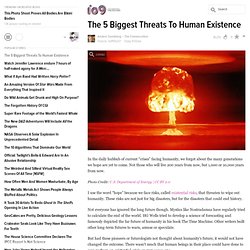
Things have a way of being connected, of creating chains and patterns. So this the downward spiral version my writer brain came up with.